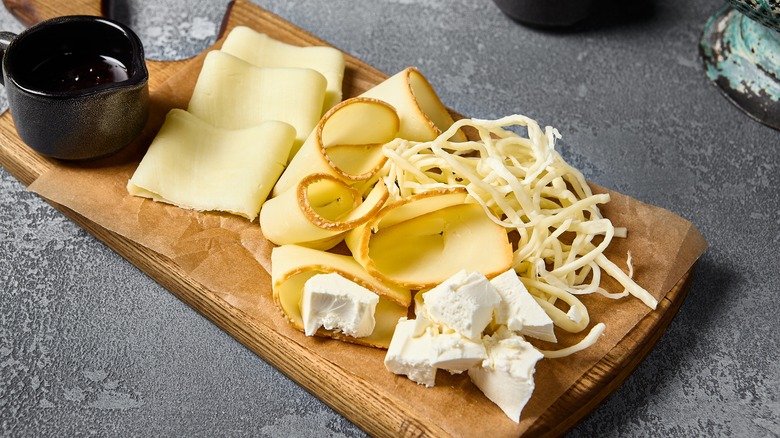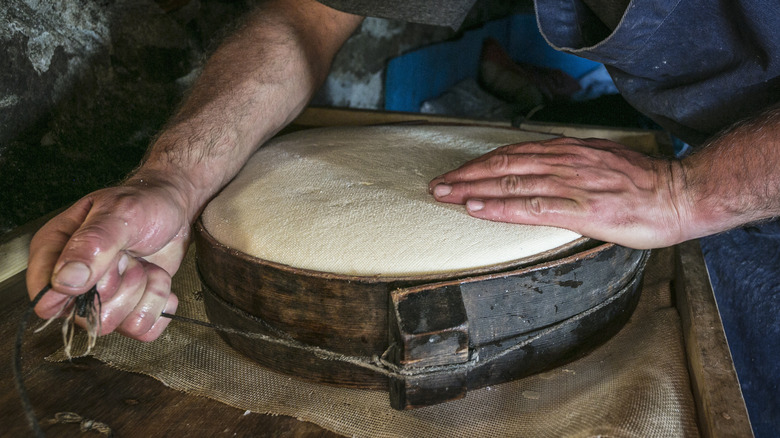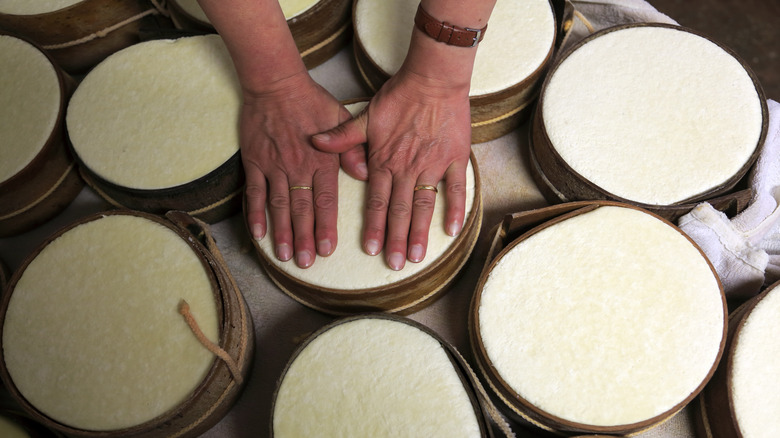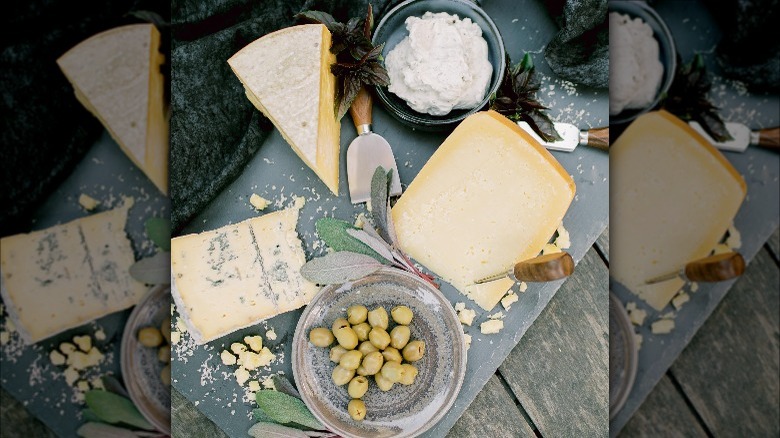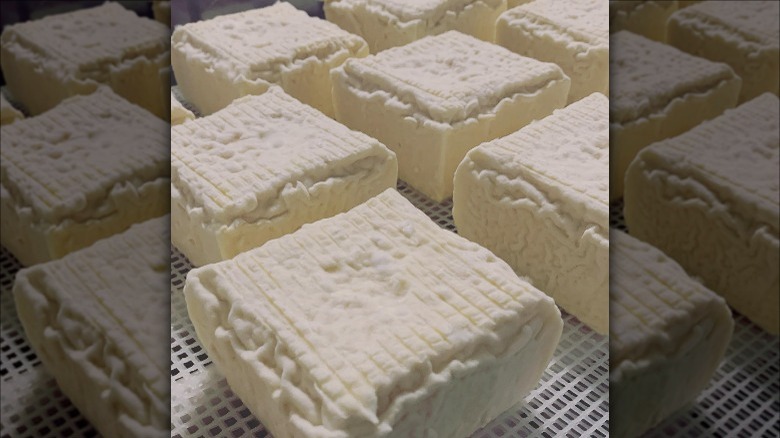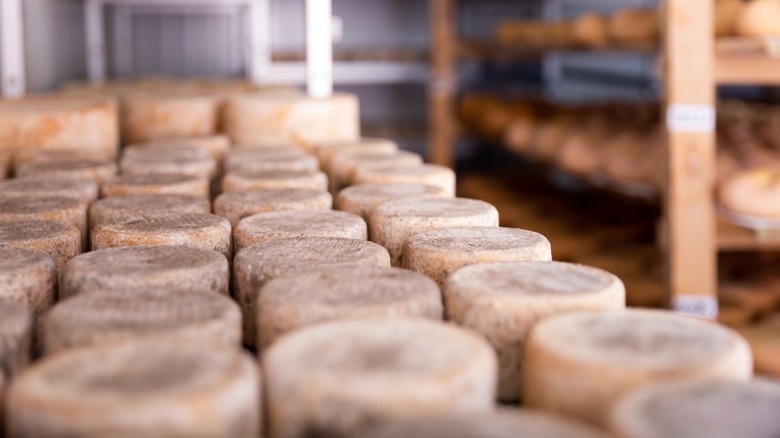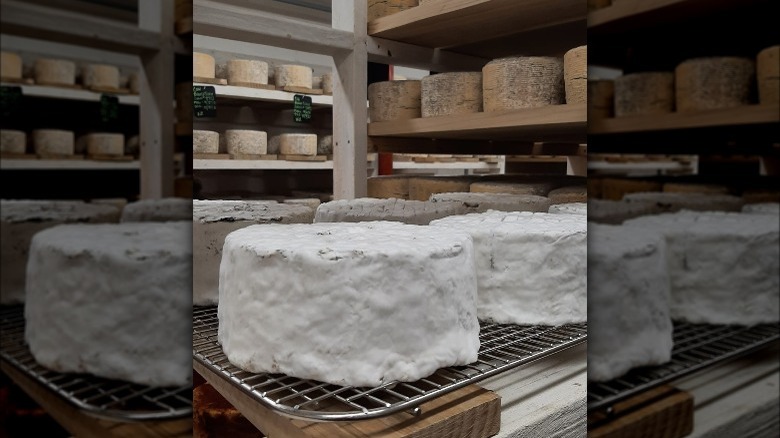What To Know Before Exploring The Indiana Cheese Guide
The Midwest is chock full of a variety of culinary trails, like Ohio's Buckeye Candy Trail, Michigan's Pasty Trail, and Illinois's Blackhawk Chocolate Trail. But Indiana has a particularly golden one — the Indiana Cheese Guide. Formerly known as the Indiana Cheese Trail, this eight-stop adventure features small, independent Indiana cheesemakers from all over the state. Though not technically a food trail in the most literal sense, the Indiana Cheese Guide invites Hoosiers and out-of-staters alike to take a look at the inner workings of one (or more) of the state's dairy farms and sample some of their specialty artisan cheeses.
But each creamery in the Indiana Cheese Guide offers a different experience to visitors, so there are a few things you should keep in mind on your Midwestern cheese tour. If you want to get the most out of the Cheese Guide, here's what you should know before you go.
Indiana's artisan cheesemaking industry is small but mighty
Indiana probably isn't the first state you think of when it comes to cheese (perhaps you're more acquainted with the famed Indiana treat, sugar cream pie). But while Indiana isn't topping the cheesemaking charts, it is home to more than 700 dairy farms, nearly all of which are family-run. Until recently, much of the milk from those dairy farms — as much as 4 million pounds per day — was leaving the state to be processed and sold elsewhere.
But, the Indiana Dairy Strategy, a 2015 initiative by the American Dairy Association Indiana (ADAI), aimed to change that trend and keep more milk in the state by processing and selling it locally. By attracting dairy producers, including cheesemakers, to Indiana and also by supporting existing Indiana dairy farmers in processing more of their own fluid milk through grants and collaborative partnerships, the goal of the Indiana Dairy Strategy (and its successor, the 2021 Dairy Strategy 2.0) is to increase domestic demand for milk.
Specialty cheesemakers, a growing industry, are a significant part of the success of the Dairy Strategies. Nearly 85% of Indiana dairy farmers have 100 dairy cows or fewer. ADAI's initiatives, like the Indiana Cheese Guide and the $2,500 Indiana Cheese Makers Grant, encourage these Indiana dairy farmers to keep more fluid milk in-house to process into artisanal cheeses and other dairy products and keep more jobs and dollars in the state.
The cheesemakers in the Indiana Cheese Guide have changed over the years
The original Indiana Cheese Trail included additional cheesemakers. Some have dropped off the list, like Schnabeltier, which closed in 2022 to enable the owners to focus on their other businesses, and Golfo di Napoli's Warren, Indiana location closed for unknown reasons. A third, Jacobs and Brichford in Connersville, Indiana, is still on the list, but while their dairy farm is still operational, the cheesemaking side of their family-run dairy farm is now closed due to the death of the patriarch, Matthew Brichford. These rapidly closing dairy farms demonstrate the struggle that many artisanal cheesemakers in Indiana face — operating a sustainable cheesemaking business is a challenge, and things can change dramatically in an instant.
But most of the stops on the original Cheese Trail are still included in the Cheese Guide, and there are some new additions as well, like Kuehnert Dairy in Fort Wayne. "We are fortunate to have great relationships with many Indiana dairy farm families," says Brooke Williams, director of communications at ADAI. "As soon as a dairy farmer decides to start processing cheese, we get their information added to the site." So, there will likely be more Indiana Cheese Guide cheesemakers to visit in the future.
Offerings can change seasonally
Depending on when you choose to visit the cheesemakers in the Indiana Cheese Guide, you may have different types of cheeses and experiences to choose from. Indiana cheesemakers often produce different cheeses at different times of the year. For example, Traders Point in Zionsville produces blue cheese year-round, fleur de la terre from April to June, Geneva from July to September, tomme from October to November, and cheddar from December to March. Tulip Tree produces most of its cheeses year-round, but a few are only made seasonally, and once they're gone, they're gone until the next season.
Your experience at certain creameries may change seasonally, too. For example, Kuehnert Dairy Farm in Fort Wayne hosts an annual fall festival from mid-September to late October with a corn maze, pedal car track, giant spiderweb, obstacle course, hayride, and more. The menu at the Loft Restaurant at Traders Point Creamery changes with the availability of seasonal ingredients, and Fair Oaks Farms has a variety of pick-your-own experiences, including sunflowers and pumpkins starting in September and pick-your-own apples from August through October.
Every stop in the Guide offers visitors a different experience
Entertaining and educating tourists are key parts of the business of some cheesemakers in the Indiana Cheese Guide, but others aren't quite so open to the public. Hufford Family Dairy in Manchester, for example, is technically part of the Guide but has no on-site offerings, while Steckler Grassfed Farms in Dale invites cheese lovers to stop in and shop but doesn't offer any official tours or events. J2K Capraio in Walkerton offers catering and event hosting onsite and operates a deli and cheese shop in town but is otherwise not open to the public.
Traders Point Creamery, on the other hand, boasts event venues, farm tours, and a full farm-to-table restaurant on site, plus a Seed and Soil series of gardening classes and a Garden Dinner Series with a seven-course seasonal menu. Kuehnert Dairy Farm offers visitors a 90-minute farm tour by appointment, where you can learn about what goes into running a cheese-processing dairy farm and even milk a cow.
Fair Oaks Farms, a literal amusement park for fromage fanatics, offers three museum experiences — the Dairy Adventure, the Pig Adventure, and the Crop Adventure — plus soy candlemaking workshops, hands-on farming lessons, and even an educational scavenger hunt for the kids. It also has three unique dining experiences — the Farmhouse Restaurant, Cowfé & Ice Cream Shop, and Dairycatessen Grab & Go. And, Tulip Tree Creamery has three levels of cheesemaking classes, from mozzarella to cheddar, and a pairing class.
The Indiana Cheese Guide is not meant to be done all in one go
The Indiana Cheese Guide features eight currently active cheesemakers spread out across the entire state, from Crystal Springs and Heritage Ridge near the northern border to Steckler Grassfed Farms in the south to Fair Oaks Farms in the east. Though once called the Indiana Cheese Trail, it was never meant to be followed all in one trip. In fact, visiting all eight creameries would take a 10-hour, 560-mile road trip. Even to visit all the creameries open to the public would take 7½ hours and 427 miles, and with all there is to do at each one, it would be impossible to see them all in a day or even a weekend, which was the major reason behind the name change.
"After launching the Indiana Cheese Trail, we received feedback that it would be difficult to actually follow the whole cheese trail in one day," says Brooke Williams. And unlike some other Midwestern food trails, there's no prize for visiting them all. So, the ADAI rebranded the trail in a way that was intended to showcase the landscape of Indiana cheesemakers rather than lead visitors on a stop-by-stop scavenger hunt. "We shifted to the Indiana Cheese Guide to serve as the best resource for those interested in meeting a local farmer/cheese maker, making a day trip out of it, and/or being able to learn more and explore ordering options without leaving home," Williams explains.
The Indiana Cheese Guide is about more than just cheese
At the heart of the Indiana Cheese Guide is, of course, cheese, but it's also about a whole lot more than that. The Cheese Guide promotes sustainable farming and shopping, encouraging visitors to explore and buy from local small businesses in small towns and big cities across the state. Some creameries featured in the Cheese Guide intentionally partner with other local vendors. Crystal Springs Creamery, for example, has a farm store selling goods from local suppliers alongside its own cheeses and dairy products, and the Dairycatessen at Fair Oaks Farms sells local beers and wines. Others, like Hufford Family Dairy and J2K Capraio, run stands at nearby Midwest farmers' markets, where you'll inevitably be tempted by other small, local businesses.
But, most importantly, the Indiana Cheese Guide is about showcasing the pride of Indiana farmers and artisans. "We are so proud of the work our Indiana dairy farmers do to reach their communities and provide delicious and nutritious products from their farm," Brooke Williams says, and encourages visitors to stop by any of the creameries in the Cheese Guide. "The passion behind the work has not only earned many accolades, but these cheese processors love nothing more than connecting with consumers along the way."
